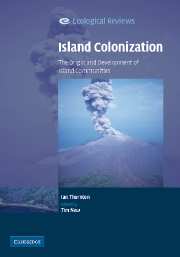Book contents
- Frontmatter
- Contents
- Editorial preface
- Acknowledgements
- PART I Theoretical and experimental studies
- PART II Natural recolonization after devastation
- PART III The recolonization of devastated islands
- 5 Recovering island biotas: Volcano and Bárcena
- 6 Thera, Santorini Group, Mediterranean
- 7 Long and Ritter Islands, Bismarck Sea
- 8 Krakatau, Sunda Strait
- PART IV Assembly of biotas on new islands
- PART V Colonization and assembly
- References
- Index
7 - Long and Ritter Islands, Bismarck Sea
Published online by Cambridge University Press: 12 January 2010
- Frontmatter
- Contents
- Editorial preface
- Acknowledgements
- PART I Theoretical and experimental studies
- PART II Natural recolonization after devastation
- PART III The recolonization of devastated islands
- 5 Recovering island biotas: Volcano and Bárcena
- 6 Thera, Santorini Group, Mediterranean
- 7 Long and Ritter Islands, Bismarck Sea
- 8 Krakatau, Sunda Strait
- PART IV Assembly of biotas on new islands
- PART V Colonization and assembly
- References
- Index
Summary
Some time around the middle of the seventeenth century AD there was a volcanic eruption at the western margin of the Pacific which, in terms of energetics, was several times larger than the Mount St Helens eruption and about the size of that of Krakatau (Blong 1982), yet the Western world has no record of the event. This was the catastrophic eruption of Long Island, some 50 km north of New Guinea and about 150 km east-north-east of Madang, in the Bismarck Sea of the western Pacific.
There is no written record of this event, but accounts of the eruption's effects have been passed down from generation to generation by the tribes of the region in oral legends and traditions and in this way have been preserved among more than 30 different language groups (Blong 1982). Because of the effects of the extensive ash clouds, people spoke of the eruption as ‘The Time of Darkness’.
The Bismarck volcanic arc
The Bismarck Sea lies north of New Guinea and New Britain, and along its southern margin runs a 1000-km-long chain of volcanoes, the Bismarck volcanic arc. The arc comprises a line of island volcanoes north of the New Guinea coast (Fig. 7.1) and a line of volcanoes along the length of New Britain. It extends from Vokeo, about 100 km north of the Sepik coastal town of Wewak in the west to the caldera port of Rabaul at the eastern end of New Britain.
- Type
- Chapter
- Information
- Island ColonizationThe Origin and Development of Island Communities, pp. 95 - 119Publisher: Cambridge University PressPrint publication year: 2007



